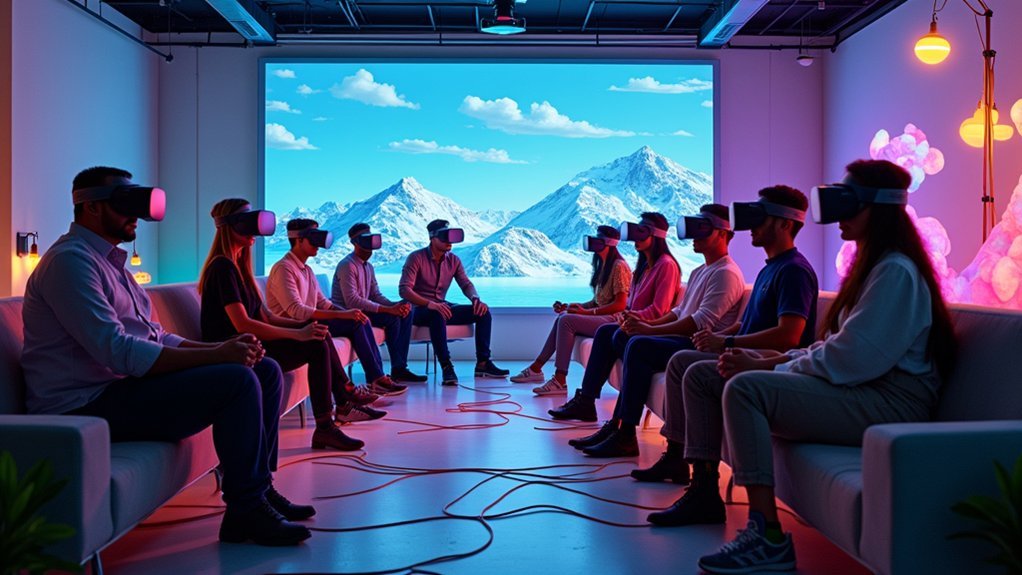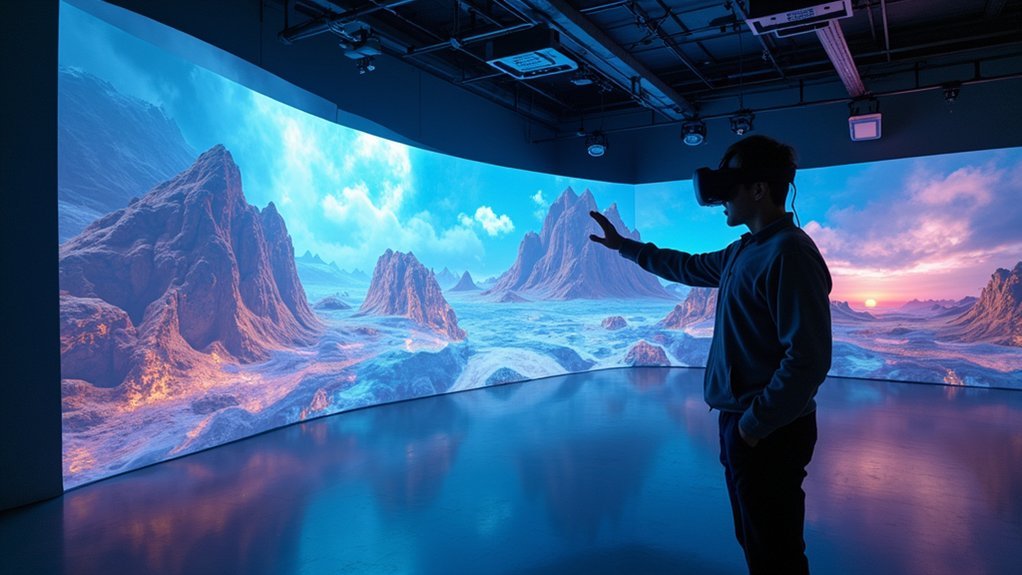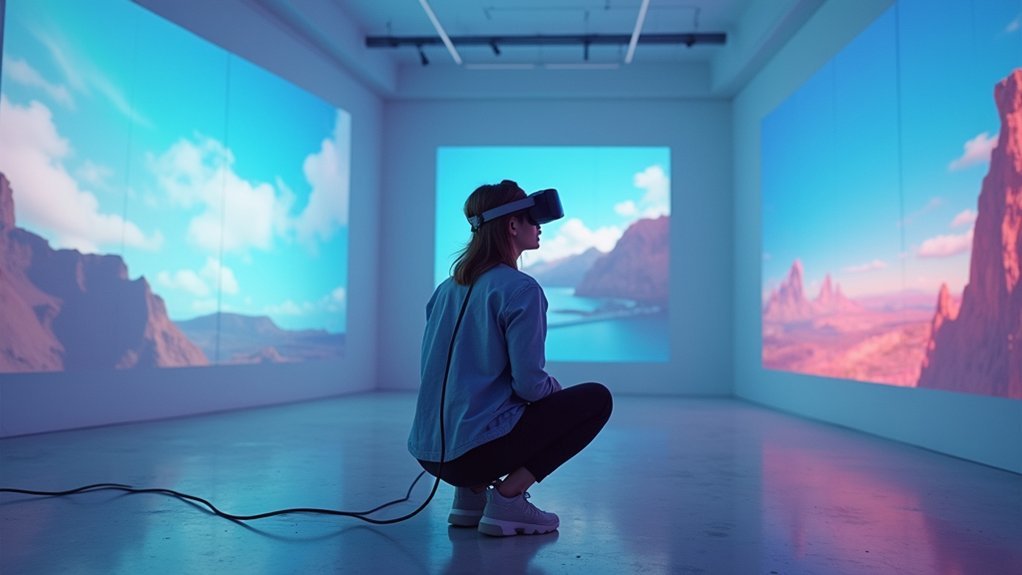You’ll navigate tethered VR’s landscape by balancing superior performance capabilities with hardware limitations while building diverse teams of technical experts, designers, and UX specialists. Focus on systematic risk assessment frameworks that evaluate technological compatibility and market competition. Prioritize immersive user experiences through optimized movement systems, spatial audio design, and comfortable ergonomics that minimize motion sickness. Leverage recent hardware advancements like eye tracking and foveated rendering to create compelling applications across gaming, healthcare, education, and remote collaboration sectors that’ll reveal deeper strategic insights.
Understanding Tethered VR Technology Capabilities and Limitations

While standalone VR headsets offer convenience and portability, tethered VR systems like the Oculus Rift and HTC Vive deliver superior performance through their connection to powerful desktop computers.
You’ll experience high-fidelity graphics and precise motion tracking that creates truly immersive environments. These systems support advanced features like room-scale tracking, making them perfect for gaming, simulation, and training applications.
However, you’ll need to invest in robust PC hardware with high-end graphics cards, which increases costs and space requirements.
The cables can restrict your movement and create physical constraints during gameplay. Extended sessions may cause user fatigue due to headset weight and physical exertion.
When choosing tethered VR, you’re balancing exceptional visual quality and tracking precision against accessibility limitations and potential user experience challenges.
Market Trends Shaping Tethered VR Development
As the VR industry has evolved since 2014, several key developments have fundamentally reshaped tethered VR’s trajectory in the marketplace.
Google Cardboard’s introduction sparked accessible VR experiences, creating demand for short, immersive content that established early user expectations.
Samsung’s Gear VR in 2015 raised the bar with superior tracking and ergonomics, expanding market reach through strategic partnerships.
Samsung’s strategic partnerships with Gear VR demonstrated how superior hardware design could rapidly expand VR’s mainstream market penetration.
The 2016 HTC Vive and Oculus Rift announcements positioned tethered VR as premium technology, attracting significant investment.
You’ll notice how major game engines like Unity and Unreal adapted to support VR applications, building a robust developer ecosystem that improved content quality.
Looking ahead, anticipated hardware advances including eye tracking and haptic feedback indicate market trends toward deeper immersion, setting new benchmarks for what users expect from tethered VR experiences.
Building Diverse Teams for VR Innovation

You’ll need technical experts, creative designers, and user experience specialists to form the backbone of your VR innovation team.
These essential skill sets create a foundation for thorough problem-solving when you’re developing tethered VR experiences.
Cross-disciplinary collaboration methods become your key tools for harnessing each team member’s unique expertise and transforming diverse perspectives into breakthrough VR solutions.
Essential Team Skill Sets
Because VR development demands both cutting-edge technical expertise and intuitive user experience design, you’ll need to assemble a team that bridges multiple disciplines effectively.
Your success hinges on cultivating team dynamics that leverage each member’s unique strengths while maintaining open communication channels that spark innovation.
Focus on recruiting these essential skill sets:
- Technical engineers who understand VR hardware constraints, rendering optimization, and platform-specific development requirements
- UX/UI designers specialized in spatial design principles, user comfort, and immersive interaction patterns
- Audio specialists experienced in 3D soundscapes, spatial audio implementation, and acoustic environment design
When you encourage collaboration between these diverse roles, you’ll create thorough solutions that address VR’s complex technical and experiential challenges.
This multidisciplinary approach guarantees your projects adapt effectively to the rapidly evolving VR landscape.
Cross-Disciplinary Collaboration Methods
When diverse VR teams succeed, they’ve mastered specific collaboration frameworks that transform individual expertise into collective innovation.
You’ll want to establish structured team meetings that rotate leadership between disciplines, ensuring technical developers, creative designers, and UX specialists each drive discussions from their perspective. This approach generates breakthrough VR experiences by combining varied viewpoints on user interaction, visual aesthetics, and system performance.
Implement cross-pollination sessions where team members shadow colleagues from different departments, fostering deeper understanding of each discipline’s challenges.
Create shared digital workspaces where prototypes, feedback, and design iterations live transparently.
Most importantly, you should designate “perspective breaks” during development cycles—moments when the team steps back to evaluate progress through each discipline’s lens, preventing tunnel vision and ensuring your VR solutions address thorough user needs.
Risk Assessment Frameworks for VR Projects
Although VR projects offer immense potential, they’re inherently complex ventures that demand systematic risk assessment from the outset.
You’ll need an extensive framework that evaluates technological, market, and user experience factors to identify potential roadblocks before they derail your progress.
Your risk assessment should prioritize threats based on likelihood and impact, enabling focused resource allocation.
Here’s how to structure your approach:
- Technological risks – Hardware compatibility issues, performance bottlenecks, and platform dependencies
- Market risks – Competition shifts, adoption rates, and changing consumer preferences
- User experience risks – Motion sickness, accessibility barriers, and content quality concerns
Foster open team communication to surface innovative mitigation strategies.
Regularly update your framework based on emerging trends and user feedback, ensuring your VR projects remain adaptable to evolving market dynamics.
Creating Immersive User Experiences in Tethered Systems

You’ll need to master audio design techniques that create convincing soundscapes, as proper spatial audio can make or break your user’s sense of presence in the virtual world.
Your spatial interaction methods must feel natural and intuitive, allowing users to manipulate objects and navigate environments without breaking immersion.
You should also optimize your movement systems to minimize motion sickness while maximizing user comfort, ensuring smooth shifts that keep players engaged rather than nauseous.
Audio Design Techniques
Sound becomes the invisible thread that weaves players into Tethered’s virtual world, transforming a visual experience into something deeply immersive. Your audio design approach should prioritize subtle enhancements over complex solutions, creating an immersive environment through careful implementation.
Effective audio design techniques include:
- Minimal height differentiation – Focus on careful mixing of distant sounds rather than overwhelming layered complexity.
- Event-specific audio handling – Develop unique techniques like strategic lightning strike layering to enhance player perception.
- Strategic music implementation – Use calming reassurance and iconographic motifs to convey gameplay information while reducing UI clutter.
You’ll find that utilizing stock Unreal Engine 4 without middleware streamlines development while preserving CPU resources.
The ambient soundscape and character-specific audio create emotional connections, making your virtual environment feel vibrant and engaging.
Spatial Interaction Methods
When you design spatial interactions for tethered VR systems, movement becomes the foundation that transforms passive observation into active participation. Your tracking system enables natural movement within defined boundaries, greatly reducing VR sickness compared to stationary setups.
Teleportation dominates spatial interaction design, appearing in 89% of VR games. This method eliminates visual vestibular conflict by providing instant viewpoint translation. However, traditional teleportation limits physical movement, prompting innovative alternatives.
Redirected Teleportation encourages you to walk more, maximizing your tracking space utilization. While requiring fewer teleports overall, this method increases walking distances and session duration.
The trade-off proves worthwhile—you’ll experience enhanced spatial awareness and better tracking space efficiency, creating more immersive and physically engaging VR experiences.
Movement System Optimization
Although teleportation offers quick navigation, optimizing movement systems requires balancing user convenience with immersive presence.
You’ll find that while 89% of VR games utilize teleportation mechanics, traditional approaches can minimize physical movement and reduce immersion. Redirected Teleportation presents a compelling alternative that encourages more walking while maintaining navigation efficiency.
When designing your movement systems, consider these optimization strategies:
- Implement hybrid approaches that combine walking with teleportation mechanics to maximize tracking space utilization.
- Reduce spatial disorientation during teleportation shifts through smoother visual cues and orientation markers.
- Balance convenience with engagement by encouraging physical movement while preserving quick navigation options.
You’ll discover that users may require more time with alternative systems, but they’ll achieve greater presence and utilize more available space, creating more immersive experiences.
Audio Design Challenges in Tethered VR Environments
Creating an immersive audio landscape for Tethered presented unique obstacles that required creative solutions within VR’s technical constraints. You’ll discover that effective audio design doesn’t always demand complex middleware or advanced technology. The team prioritized stock Unreal Engine 4 integration, focusing on seamless performance over intricate solutions.
Your VR experience benefits from strategic event-specific techniques, particularly when handling dramatic moments like lightning strikes through careful audio layering. The design philosophy emphasized subtle enhancements that strengthened emotional connections with Peeps while maintaining efficient resource management.
| Challenge | Solution |
|---|---|
| Resource Management | Stock UE4 implementation |
| Emotional Connection | Ambient soundscape focus |
| Event Perception | Layered audio techniques |
| Team Coordination | Collaborative refinement process |
Collaboration proved essential in maintaining audio quality throughout development, ensuring your immersive experience remained smooth and engaging.
Hardware Advancements in Tethered VR Systems
Hardware evolution has transformed tethered VR systems from experimental prototypes into sophisticated gaming platforms that deliver unprecedented immersion.
Modern hardware advancements have revolutionized how you experience virtual worlds through cutting-edge VR headsets like the Oculus Rift and HTC Vive.
Key breakthrough technologies enhancing your VR experience include:
- Eye tracking integration – Enables foveated rendering that optimizes performance by reducing graphical load in your peripheral vision while maintaining crisp central visuals.
- Enhanced ergonomic design – Lighter headsets with improved weight distribution let you enjoy extended gaming sessions without neck strain or discomfort.
- Powerful GPU integration – Advanced graphics processing delivers richer environments and complex visual effects that push the boundaries of photorealistic virtual worlds.
These innovations, combined with spatial audio capabilities and precise movement tracking, create truly immersive experiences.
Movement Mechanics and Navigation Solutions
When you’re exploring virtual worlds in tethered VR, you’ll quickly discover that traditional walking isn’t always practical due to your limited physical space.
You’ll need to master teleportation-based movement systems that let you traverse vast digital environments while staying within your room’s boundaries.
Your movement choices directly impact both your sense of presence and how much physical activity you’ll get during each VR session.
Teleportation Implementation Strategies
Since teleportation serves as the primary movement mechanism in 89% of VR games, understanding its implementation becomes essential for creating comfortable and engaging virtual experiences.
You’ll need to take into account how different teleportation implementation strategies affect user behavior and comfort levels.
When evaluating your options, focus on these key considerations:
- Traditional teleportation provides instant viewpoint translation that eliminates visual vestibular conflict and reduces VR sickness effectively.
- Redirected Teleportation encourages physical movement but increases overall travel times despite requiring fewer teleports.
- User preference patterns from coin collection tasks show traditional methods win over Redirected Teleportation due to better learnability and reduced spatial disorientation.
You’ll want to balance movement encouragement with user comfort, as heat maps reveal players often remain stationary despite expensive tracking systems.
Physical Movement Constraints
Beyond implementing teleportation systems, you’ll face fundamental limitations imposed by your physical environment. Your home’s tracking space restricts natural walking and exploration, forcing you to rely heavily on artificial movement methods.
Studies show that players often remain stationary during gameplay, questioning whether expensive VR systems truly deliver on their physical movement promises.
You’ll find that 89% of VR games use teleportation precisely because it reduces motion sickness while accommodating space constraints. However, this creates a design challenge: players prefer quick navigation over physical movement, yet immersion suffers when you’re stationary.
Redirected Teleportation offers a promising compromise, encouraging actual walking while teleporting. This technique increases your travel distance and maximizes your available space, bridging the gap between convenience and authentic physical movement.
Content Creation Strategies for Tethered Platforms
Although tethered VR platforms demand more technical resources than their standalone counterparts, they offer content creators unparalleled opportunities to craft truly immersive experiences.
You’ll want to leverage high-fidelity graphics and advanced tracking capabilities that distinguish tethered systems from mobile alternatives.
Your content creation strategy should focus on three key elements:
- Incorporate user feedback loops throughout development to refine experiences based on engagement metrics
- Design immersive storytelling that takes advantage of superior visual fidelity and precise motion tracking
- Integrate innovative audio design that complements stunning visuals for complete sensory engagement
Game engines like Unity and Unreal have evolved specifically to support VR development, making it easier to create visually impressive experiences.
Don’t overlook social and multiplayer elements, as shared experiences represent VR’s future direction.
Future Applications Beyond Gaming and Entertainment
While powerful content creation tools have established tethered VR’s dominance in gaming and entertainment, the technology’s most transformative impact may emerge from applications that extend far beyond these traditional domains.
You’ll find education revolutionizing through immersive virtual worlds where students engage with complex subjects via interactive simulations.
Healthcare professionals now train surgical skills without risk, while VR therapy reduces patient anxiety considerably.
Architecture firms let clients walk through buildings before construction begins, transforming decision-making processes.
Remote collaboration tools create virtual meeting spaces that enhance distributed team productivity.
Tourism companies offer virtual destination previews, helping travelers make informed choices.
Unlike a VR game focused on entertainment, these applications solve real-world problems and create measurable value across industries.
Frequently Asked Questions
How Do I Navigate in VR?
You’ll primarily use teleportation by pointing your controller and selecting destinations to instantly move around virtual environments. You can also walk within your physical tracking space or use thumbstick movement in some games.
What Are the Navigation Techniques for Virtual Reality?
You can navigate VR using teleportation, which instantly moves your viewpoint to reduce motion sickness. There’s also redirected teleportation, where you’ll step into portals, promoting more physical movement within your limited tracking space.
How Do You Walk Around in VR Games?
You’ll physically walk within your tracking space, but you’ll primarily use teleportation by pointing controllers and selecting destinations. Most games combine both methods, letting you take real steps while teleporting for longer distances.
How to Change VR Position?
You can change your VR position by using teleportation mechanics, physically moving within your play space, or accessing in-game position reset options through your headset’s menu system.





Leave a Reply